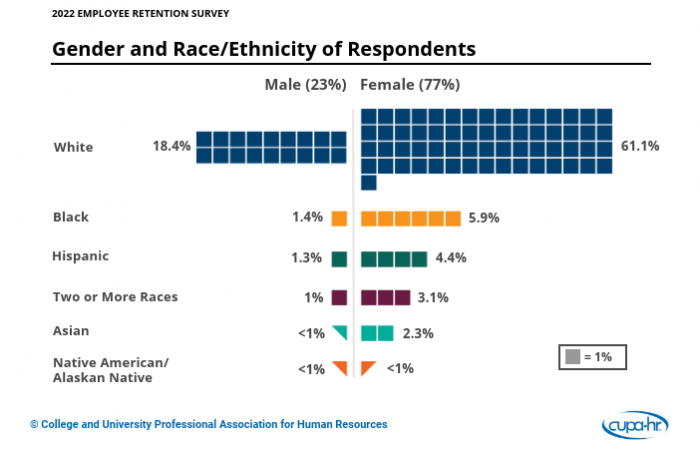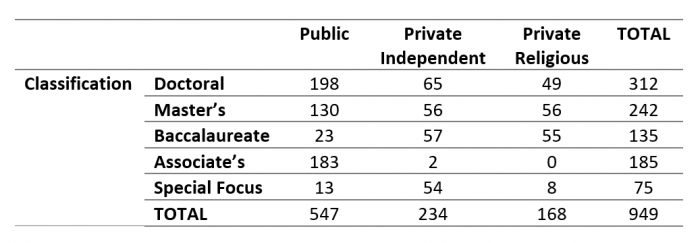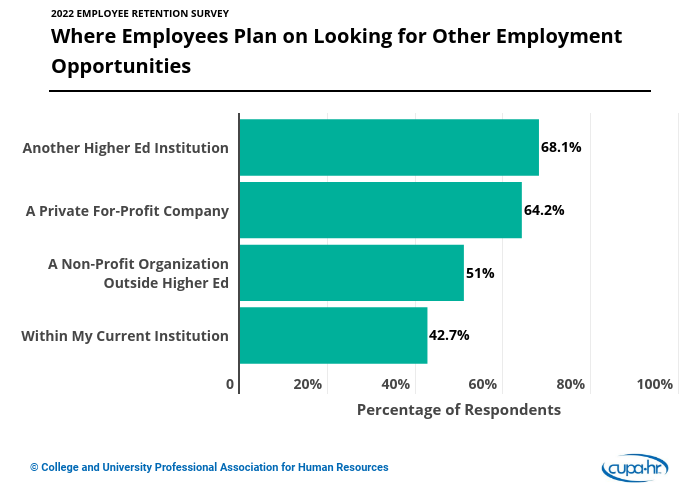The CUPA-HR 2022 Higher Education Employee Retention Survey: Initial Results
By Jacqueline Bichsel, Melissa Fuesting, Jennifer Schneider, and Diana Tubbs | July 2022
Introduction
The CUPA-HR Higher Education Employee Retention Survey was piloted in May 2022.1The data collection period for the survey was May 2 to May 20, 2022. The survey was created to better understand the proportion of the higher ed workforce that is at risk for leaving their current jobs, why these employees are considering leaving, and what higher ed institutions can implement to increase retention and improve the higher ed workplace. The survey was targeted to all higher ed employees who are not faculty — administrators, professionals, and non-exempt staff.2We thank the following professional organizations who partnered with CUPA-HR in distributing this survey to their members: AACRAO, ACHA, ACPA, ACUHO-I, ACUI, CHEMA, EDUCAUSE, NACUBO, NASFAA, NCCI. We thank the members of those organizations who distributed this survey to employees at their institutions and the employees who took the time to provide responses to this survey.
The survey asked questions in the following areas:
- Likelihood of looking for other employment opportunities in the near future
- Reasons for looking for other employment
- Remote work policies and opportunities
- Work performed beyond normal hours and duties
- Satisfaction with benefits
- Well-being and satisfaction with job environment
- Challenges for supervisors
- Demographic questions on gender, race/ethnicity, and age
- Characteristics of the employee’s position
This report focuses on the broad, initial results obtained for most of these questions. Descriptive analyses provide an overview of what proportion of the higher ed workforce is at risk for leaving, why they’re considering leaving employment, and with which policies, work arrangements, and benefits employees are satisfied or dissatisfied. Differences by institution classification, affiliation, and employee department/area are discussed where these differences are notable.3Future reports will take deeper dives into the challenges faced by supervisors; the relative importance of the various survey factors in predicting which employees are at most risk of leaving; and differences in responses by gender, race/ethnicity, and age.
Respondents
Data from 3,815 higher ed employees were analyzed for this report.4Although 3,926 people completed the survey, 111 responses were excluded for one or more of the following reasons: their institution could not be identified or classified, their department or work area could not be classified, or they could not identify whether they were full-time or part-time. More than three fourths (77%) of the sample were female, and 80% were White (Figure 1).5Reported for those responding to the questions asking for self-identification of gender (97% of the sample) and race/ethnicity (96% of the sample). A “nonbinary” category was included in the gender item of the survey, although the number of employees responding as nonbinary (n = 43) could not be meaningfully depicted in this intersectional graphic. More than half (57%) were supervisors, with an average of 3.76 staff reporting to them. Nearly all (98%) respondents were full-time employees.
Figure 1. Gender and Race/Ethnicity of Respondents
Respondents worked in a variety of departments/areas (Figure 2). The department with the greatest representation in the survey was human resources (31%), followed by student affairs (21%).6Departments/areas with n < 100 (representing < 3% of survey respondents) are not included in comparative analyses of departments/areas in this report.
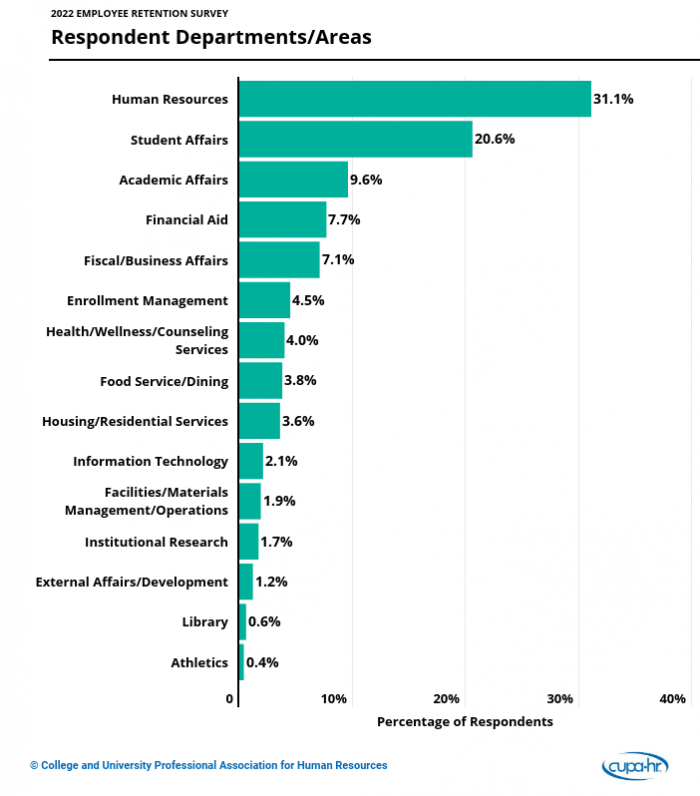
Figure 2. Respondent Departments/Areas
Respondents represented 949 institutions, as illustrated in Table 1.
Table 1. Institution Classification and Affiliation
Likelihood of Looking for Other Employment Opportunities in the Near Future
The first question of the Employee Retention Survey asked, “What is the likelihood that you will be looking for other employment opportunities within the next 12 months?” Figure 3 shows the distribution of responses to this question. Approximately 35% of higher ed employees are likely or very likely to look for new employment opportunities in the next year, and an additional 22% are somewhat likely to look for new employment in the next year.7Analyses of this data found no notable differences in results due to institution classification, institution affiliation, or employee department/area. The proportion of higher ed employees at risk of leaving has increased since 2021, where only 24% reported that they were either likely or very likely to look for new employment opportunities, and an additional 19% were somewhat likely.8Bichsel, J., Fuesting, M., & McCormack, M. (2021, November). Providing Remote Work Opportunities Will Aid Your Retention Efforts. CUPA-HR. These results indicate that higher ed institutions are at risk of losing half of their current employees in the next year. In addition, the problem of retention appears to be getting worse rather than better.
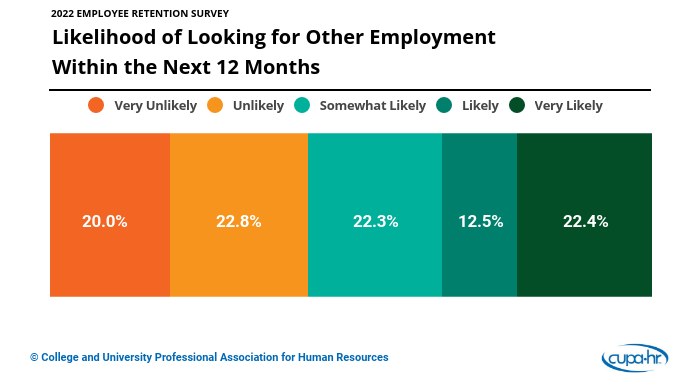
Figure 3. Likelihood of Looking for Other Employment Within the Next 12 Months
Figure 4 shows the types of organizations in which employees would look for new opportunities.9Participants who reported they were either very likely, likely, or somewhat likely to look for new work opportunities in the next year were asked to complete survey questions about where they would look for work (n = 2,183). Response options allowed participants to select all that applied. Approximately two-thirds (68%) would look for employment at another higher ed institution, and 43% of higher ed employees would look for new employment within their current institution. However, employees are not averse to seeking employment outside of higher ed: half (51%) would seek opportunities at non-profit organizations and nearly two-thirds (64%) would look for opportunities at a private for-profit company. Given the distribution of responses, results show no discernible difference between employees’ preferences for staying in or leaving higher education. The good news is that most employees remain open to job opportunities within higher education, which indicates that efforts to retain these employees can be fruitful.10Analyses of this data found no notable differences in results due to institution classification, institution affiliation, or employee department/area.
Figure 4. Where Employees Plan on Looking for Other Employment Opportunities
Figure 5 shows the reasons why higher ed employees are looking for other employment.11Participants who reported they were either very likely, likely, or somewhat likely to look for new work opportunities in the next year were asked to complete survey questions about the reasons why they would look for new work opportunities (n = 2,183). Response options allowed participants to select all that applied. More than three-fourths (76%) are seeking new employment because they want an increase in pay. Close to half (43%) desire remote work opportunities, nearly one-third (32%) want more flexible work schedules, and 30% of employees are seeking a promotion or more work responsibilities.12Analyses of this data found no notable differences in results due to institution classification, institution affiliation, or employee department/area.
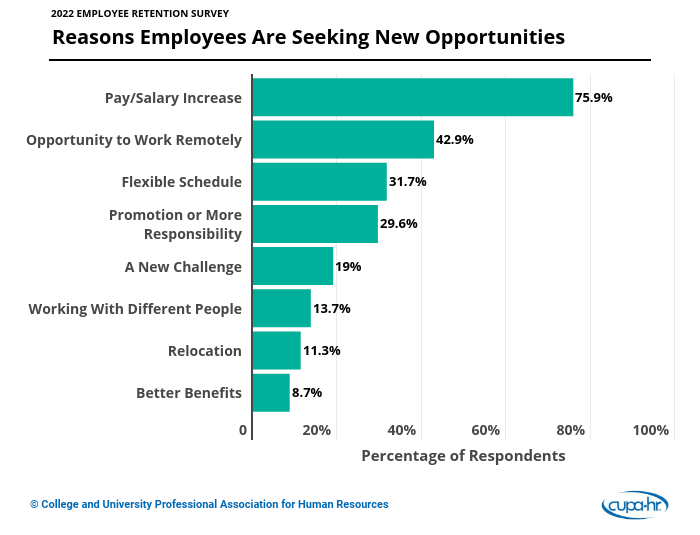 Figure 5. Reasons Employees Are Seeking New Opportunities
Figure 5. Reasons Employees Are Seeking New Opportunities
Remote Work: What Exists, What Employees Want, What Is Possible
The Employee Retention Survey included three items on remote work:
- Whether most job duties can be done remotely (responses range from strongly agree to strongly disagree)
- Actual current work arrangement (completely on-site, mostly on-site, partially on-site and partially remote, mostly remote, completely remote)
- Ideal work arrangement (completely on-site, mostly on-site, partially on-site and partially remote, mostly remote, completely remote)
Nearly three-fourths (71%) of respondents overall stated they agree or strongly agree that most of the duties of their job can be done remotely, and agreement with this statement varied somewhat predictably by job area (Figure 6). For example, 83% of human resources employees agreed that most of their duties could be done remotely, compared to only 23% of food service/dining employees.
Employees’ agreement with whether most of their duties can be done remotely does not align with their actual work arrangements. Only 14% of respondents overall have mostly or completely remote work arrangements, 23% have a hybrid arrangement with some remote and some on-site work, and 63% work completely or mostly on-site (Figure 6). Fiscal/business affairs is the area with the most employees working mostly or completely remote (25%), and, predictably, food service/dining employees are the least likely to work mostly or completely remote (1%). Noteworthy as well are departments that have a high percentage of employees stating most of their duties can be done remotely with a much lower percentage of employees working completely or mostly remote. For example, 83% of financial aid employees state that most of their duties can be done remotely, yet only 11% of them have mainly remote work arrangements, and two-thirds are working mostly or completely on-site.
When comparing current and ideal work arrangements, a number of patterns stand out. First, the most desirable work arrangement for employees overall appears to be a hybrid one, having some days where they work on-site and some days where they work remotely. There are a few exceptions to this. More fiscal/business affairs employees prefer a completely or mostly remote work arrangement, and employees in health/wellness/counseling, food service/dining, and housing/residential services prefer a completely or mostly on-site work arrangement. These exceptions are best understood when viewing the alignment between preferred work arrangements and the percentage of employees who agree that most of their duties can be done remotely.
For many departments/areas, there is a clear misalignment between actual work arrangements and preferred work arrangements. For example, only about one-third (35%) of enrollment management employees prefer to work completely or mostly on-site, but two-thirds (66%) actually do. Previous research shows that such misalignment between actual and ideal work arrangements predicts an employee’s likelihood of looking for other work in the near future.13Bichsel, J., Fuesting, M., & McCormack, M. (2021, November). Providing Remote Work Opportunities Will Aid Your Retention Efforts. CUPA-HR.
Figure 6. Current and Preferred Work Arrangements (Interactive Graphic)
Beyond Full-Time: Many Higher Ed Employees Are Burning the Candle at Both Ends
Approximately two-thirds (67%) of full-time higher ed employees work more hours each week than what is considered full-time (Figure 7).14Data in Figure 7 was obtained by calculating the difference between the number of hours each participant typically works per week and the number of hours their institution considers full-time. Notably, 10% of employees work 16 hours or more of additional hours per week. Only 1% of employees typically work less than is expected of full-time workers at their institution.
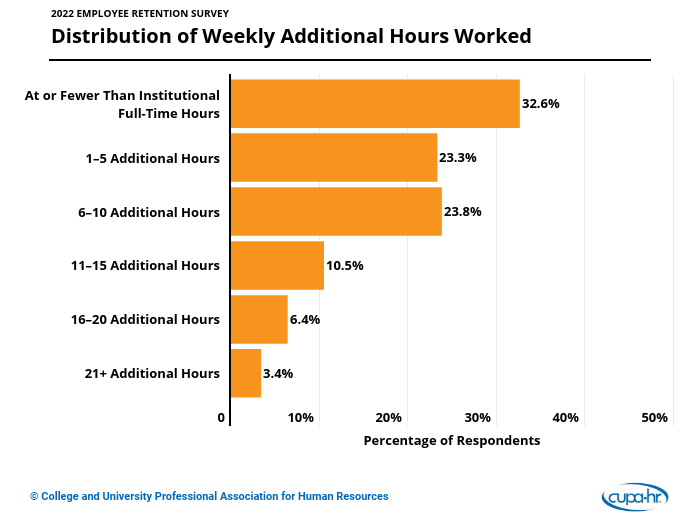
Figure 7. Distribution of Weekly Additional Hours Worked
Higher ed employees find it necessary to work additional hours to complete their current job duties. More than half (58%) of employees agreed that their job duties require additional hours, and only one-quarter (26%) disagreed that their job duties required additional hours. Nearly two-thirds (63%) of higher ed employees agreed that they absorbed additional responsibilities of other staff who left since the onset of the pandemic, and nearly three-fourths (73%) agree that they have taken on additional responsibilities that emerged due to the pandemic. Higher ed employees today have fewer hands to share a heavier load.15Analyses of this data found no notable differences in results due to institution classification, institution affiliation, or employee department/area.
Satisfaction With the Higher Ed Work Environment
The Employee Retention Survey contained 14 items related to work environment and job satisfaction. Employees were asked to rate the extent to which they agree with statements such as “I feel a sense of belonging at work.” Figure 8 displays the percentage of respondents agreeing with each statement.16Questions used a five-point Likert scale of agreement (Strongly Disagree, Disagree, Neither Agree nor Disagree, Agree, Strongly Agree). Overall, nearly two-thirds (62%) of higher ed employees agree with the general statement that they are satisfied with their job. Approximately the same percentage (66%) would recommend their department as a place to work, and a slightly smaller percentage (60%) would recommend their institution. However, more than one-fifth (22%) of higher education employees are not satisfied with their jobs. Therefore, it is worth noting which aspects of their work environment receive more or less satisfaction.
Higher ed employees overwhelmingly agree (81%) they have a good relationship with their supervisor, which research shows is positively associated with job satisfaction for both in-person and remote employees.17Stringer, L. (2006). The Link Between the Quality of the Supervisor–Employee Relationship and the Level of the Employee’s Job Satisfaction. Public Organization Review, 6, 125-142. doi: 10.1007/s11115-006-0005-0 , 18Golden, T. D. & Veiga, J. F. (2008). The Impact of Superior–Subordinate Relationships on the Commitment, Job Satisfaction, and Performance of Virtual Workers. The Leadership Quarterly, 19(1), 77-88. doi: 10.1016/j.leaqua.2007.12.009 Further, more than three-fourths (77%) feel their work has purpose. In addition, approximately two-thirds of employees agree they are valued by others at work (67%), feel they can bring up problems and tough issues at work (65%), and feel a sense of belonging (64%).
There are four notable areas of discontent. Nearly half (46%) of higher ed employees disagree they have opportunities for advancement and a similar percentage disagree they are paid fairly (45%). Thirty-nine percent disagree that the institution is invested in their career development and one-fourth (24%) disagree that they are recognized for their contributions.
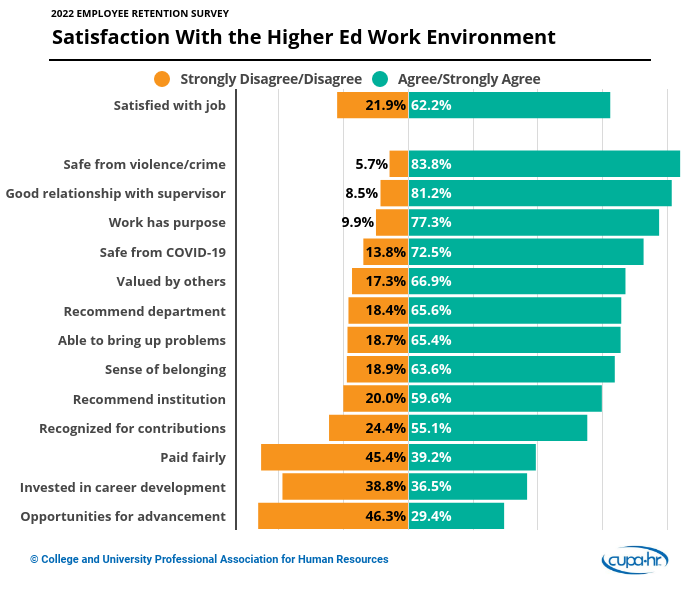
Figure 8. Satisfaction With the Higher Ed Work Environment
When comparing these results by institution classification, higher ed employees in baccalaureate institutions perceive their work environment most favorably (highest agreement to 10 of the 14 items), whereas those in associate’s institutions perceive their work environment least favorably (lowest agreement to 10 of the 14 items). Likewise, those in private institutions (independent and religious) had more positive responses (highest agreement to 13 of the 14 items) than those in public institutions.
Employee job satisfaction varies by department/area as well. Higher ed employees working in Human Resources and Food Service/Dining are most satisfied with their job (71% and 68% agreement respectively), whereas only 55% of those in Financial Aid and in Academic Affairs agreed they were satisfied with their job. Employees in Human Resources, along with Food Service/Dining and Enrollment Management, are also the most likely to recommend their department as a good place to work (72%, 69%, and 67% respectively); however, only 54% of Financial Aid employees recommend their department as a good place to work.
Satisfaction With Benefits
When it comes to employee satisfaction with benefits, there’s a clear distinction between satisfaction with benefits that have remained fairly constant in terms of their importance over the past few years and benefits that became more salient over the course of the pandemic. For the most part, there is high satisfaction with the following: retirement benefits, amount of paid time off, health insurance, work-related equipment, and tuition reimbursement (Figure 9). More than two-thirds of higher ed employees report being satisfied or very satisfied with these benefits.
However, benefits that have become more salient since the pandemic — childcare discounts or subsidies, remote work policies, schedule flexibility, and parental leave policies — received the highest levels of dissatisfaction. This is noteworthy when one considers the research showing that women were disproportionately burdened with unpaid childcare, eldercare, and other home responsibilities during the years of the pandemic, resulting in promotion, pay, and morale gaps that continue.19Miller, C. C. (2021, May 17). The Pandemic Created a Child-Care Crisis. Mothers Bore the Burden. The New York Times.
There are some notable differences in satisfaction with benefits based on institution type. Although 81% of employees overall reported they were either satisfied or very satisfied with their retirement benefits, only 68% of public institution employees reported this level of satisfaction with retirement benefits. Similarly, only 62% of employees at public institutions reported satisfaction with their health insurance, compared to 75% overall.
Those who work at doctoral institutions report higher levels of satisfaction with their institution’s remote work policies (46% of doctoral institution employees are satisfied, compared with 35% of associate’s, 36% of baccalaureate, and 32% of master’s institution employees). Similarly, higher levels of satisfaction with parental leave policies are reported at doctoral institutions (46%) than at associate’s (33%), baccalaureate (41%), or master’s (35%) institutions. In regard to childcare discounts/subsidies, only 9% of associate’s institution employees reported they were satisfied or very satisfied. Private religious institutions reported the greatest level of satisfaction with childcare discounts/subsidies (24%); however, this is still a very low level of satisfaction.
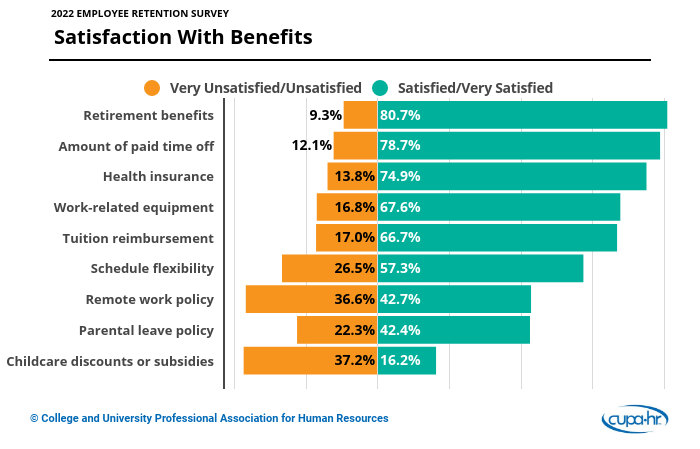
Figure 9. Satisfaction With Benefits
Conclusions
This initial report from the CUPA-HR Higher Education Employee Retention Survey provides data supporting the following broad conclusions about the higher ed workforce.
Higher ed employees are looking for other jobs, mostly because they desire a pay increase. More than half (57%) of the higher ed workforce is at least somewhat likely to look for other employment opportunities in the next 12 months. The most common reason for seeking other employment (provided by three-fourths of those likely to look for another job) is an increase in pay. Other reasons are that they desire more remote work opportunities, a more flexible schedule, and a promotion or more responsibility.
Higher ed institutions are not providing the remote work opportunities that employees want. Nearly three-fourths (71%) of employees report that most of their duties can be performed remotely, and 69% would prefer to have at least at least a partially remote work arrangement, yet 63% are working mostly or completely on-site.
Higher ed employees are working longer and harder than ever. Two-thirds (67%) of full-time staff typically work more hours each week than what is considered full-time. Nearly two-thirds (63%) have taken on additional responsibilities of other staff who have recently left, and nearly three-fourths (73%) have taken on additional responsibilities as a direct result of the pandemic.
Higher ed employees have clear areas of satisfaction and dissatisfaction. Employees are generally satisfied with most traditional benefits, and 81% have a good relationship with their supervisor. Approximately two-thirds report being satisfied with their job and would recommend their department and their institution as a good place to work. Three-fourths feel their work has purpose, and two-thirds feel valued, feel like they can bring up problems, and feel a sense of belonging. However, there are several areas in which a great deal of dissatisfaction exists:
- Investment in career development
- Opportunities for advancement
- Recognition for contributions
- Fair pay
- Parental leave policies
- Childcare discounts or subsidies
- Remote work policies
- Schedule flexibility
Recommendations
The results of the Employee Retention Survey suggest that higher ed in general is facing a crisis in retaining its talent. The results also suggest some targeted recommendations that could help mitigate this crisis.
Provide salary increases wherever possible. Many higher ed employees do not feel they’re being paid fairly, and a higher salary is by far the primary reason they look for other employment opportunities. An obvious solution would be to budget for salary increases. Higher ed institutions overall provided little or no pay increases at the height of the pandemic and pay increases since that time have not kept pace with inflation.20CUPA-HR. (2022). Annual Pay Increases by Position Type [Interactive graphic]. Implementing targeted equity increases wherever possible may be one of the most effective ways of addressing problems with retention. However, many higher ed institutions are coping with both short- and long-term budget issues that prevent large-scale pay increases. Fortunately, the results from the survey indicate other solutions that may improve retention without breaking budgets.
Offer more in the way of remote work options and flexible schedules. Employees who can work remotely now expect to be provided with opportunities to work remotely. The results from this and previous research suggest that a misalignment between employees’ preference for remote work arrangements and their actual work arrangements relates to their likelihood of looking for other employment opportunities.21Bichsel et al., 2021. Results from these surveys also suggest that huge shifts in work arrangements are not necessary. Providing even small accommodations — such as one day a week when an employee can work from home — can go a long way in improving employee satisfaction.22Ibid.
There are also other options for providing flexibility in schedules that can improve retention. Reducing the number of hours in a work week (e.g., changing the conception of full-time work from 40 hours to 36) or allowing employees to work a half-day on Fridays are just two examples of this. Asking employees what they want or need in terms of schedule flexibility would provide you with localized data that will help you target these efforts.
Results from this survey, as well as anecdotal examples from CUPA-HR members, suggest that many institutional leaders are not shifting from a culture of exclusively on-campus work to a culture of increased flexibility. The data make it increasingly clear that these leaders will need to weigh the importance of retaining talent with the importance of requiring all employees to complete all, or the majority, of their work on-site.
Be mindful of employee workload and expectations around working hours. Two-thirds of higher ed employees are working more hours than what is considered to be full-time; some are working many more. This can be attributed to the fact that employees are absorbing the responsibilities of staff who have left and additional responsibilities that emerged over the course of the pandemic. Supervisors should consider strategies to reduce employee workload. Working long hours is a key predictor of employees’ work stress, mental health, and general occupational health.23Wong, K., Chan, A. H. S., & Ngan, S. C. (2019). The Effect of Long Working Hours and Overtime on Occupational Health: A Meta-Analysis of Evidence From 1998 to 2018. International Journal of Environmental Research and Public Health, 16, 2102-2124. doi: 10.3390/ijerph16122102 In addition, leaders concerned about retention must consider the message sent when the employees who stay receive higher workloads for their loyalty. An increase in workload without an accompanying increase in pay — particularly when this condition is sustained — is a recipe for an employee who will be open to considering a new position elsewhere.
Look for new ways to recognize employees for their achievements, invest in their career development, and offer opportunities for advancement. One quarter of the respondents on the Employee Retention Survey do not feel their institution recognizes them for their contributions; nearly 40% do not feel their institution invests in their career development; and close to half do not believe they’re offered opportunities for advancement. Supervisors sometimes confuse equality with fairness and may unduly prioritize treating all their staff equally over the importance of recognizing individual contributions and the need for individualized programs of development and flexibility.24Phillips, A. (2020, September). How to Ensure Your Employees Are Treated Equally and Fairly. The HR Tech Weekly. Workplace cultures that emphasize the importance of treating all employees the same risk losing top talent who need individualized recognition, development, and opportunities to advance in order to thrive.25Lowisz, S. (2022, February). Why HR Should Not Treat Everyone the Same. Forbes.
Enhance your institution’s parental leave policies and childcare discounts or subsidies. Women have always been disproportionately burdened by dependent care responsibilities, and this condition was exacerbated over the course of the pandemic, leading many more women than men to leave the U.S. workforce.26Fields, S. (2022, February). Child Care Disruptions Have Been Driving More Women Than Men to Quit Their Jobs. Marketplace. The provision and enhancement of benefits that would mitigate this burden and address these gaps might help improve retention rates for women in the higher ed workforce.
Find ways to communicate and promote the things you’re doing right. Do you provide benefits that exceed those provided by your regional and local competitors? Do you have remote work options or other flexible work arrangements that are attractive to current employees and potential applicants for open positions? Do you provide excellent opportunities for career development and advancement? Are you providing employees with pay that exceeds the market median? Do you have recent climate survey results that are stellar? You may already be promoting the things your institution is doing right when you develop job descriptions or postings designed to attract applicants. How often, though, are you communicating these assets to your current staff? Keeping the benefits of working at your institution salient for the employees who currently work for you increases the chance that these benefits will be top of mind if and when they consider other employment opportunities.
About the Authors:
Jacqueline Bichsel, Ph.D., is director of research at CUPA-HR.
Melissa Fuesting, Ph.D., is a senior survey researcher at CUPA-HR.
Jennifer Schneider, Ph.D., is a survey researcher at CUPA-HR.
Diana Tubbs, Ph.D., is a survey researcher at CUPA-HR.
Graphics were created by Kate Roesch, data visualization developer at CUPA-HR.
Citation for This Report:
Bichsel, Jacqueline; Fuesting, Melissa; Schneider, Jennifer; & Tubbs, Diana. (2022, July). The CUPA-HR 2022 Higher Education Employee Retention Survey: Initial Results. CUPA-HR. https://www.cupahr.org/surveys/research-briefs/higher-ed-employee-retention-survey-findings-july-2022
 2 We thank the following professional organizations who partnered with CUPA-HR in distributing this survey to their members: AACRAO, ACHA, ACPA, ACUHO-I, ACUI, CHEMA, EDUCAUSE, NACUBO, NASFAA, NCCI. We thank the members of those organizations who distributed this survey to employees at their institutions and the employees who took the time to provide responses to this survey.
2 We thank the following professional organizations who partnered with CUPA-HR in distributing this survey to their members: AACRAO, ACHA, ACPA, ACUHO-I, ACUI, CHEMA, EDUCAUSE, NACUBO, NASFAA, NCCI. We thank the members of those organizations who distributed this survey to employees at their institutions and the employees who took the time to provide responses to this survey.
 3 Future reports will take deeper dives into the challenges faced by supervisors; the relative importance of the various survey factors in predicting which employees are at most risk of leaving; and differences in responses by gender, race/ethnicity, and age.
3 Future reports will take deeper dives into the challenges faced by supervisors; the relative importance of the various survey factors in predicting which employees are at most risk of leaving; and differences in responses by gender, race/ethnicity, and age.
 4 Although 3,926 people completed the survey, 111 responses were excluded for one or more of the following reasons: their institution could not be identified or classified, their department or work area could not be classified, or they could not identify whether they were full-time or part-time.
4 Although 3,926 people completed the survey, 111 responses were excluded for one or more of the following reasons: their institution could not be identified or classified, their department or work area could not be classified, or they could not identify whether they were full-time or part-time.
 5 Reported for those responding to the questions asking for self-identification of gender (97% of the sample) and race/ethnicity (96% of the sample). A “nonbinary” category was included in the gender item of the survey, although the number of employees responding as nonbinary (n = 43) could not be meaningfully depicted in this intersectional graphic.
5 Reported for those responding to the questions asking for self-identification of gender (97% of the sample) and race/ethnicity (96% of the sample). A “nonbinary” category was included in the gender item of the survey, although the number of employees responding as nonbinary (n = 43) could not be meaningfully depicted in this intersectional graphic.
 6 Departments/areas with n < 100 (representing < 3% of survey respondents) are not included in comparative analyses of departments/areas in this report.
6 Departments/areas with n < 100 (representing < 3% of survey respondents) are not included in comparative analyses of departments/areas in this report.
 7 Analyses of this data found no notable differences in results due to institution classification, institution affiliation, or employee department/area.
7 Analyses of this data found no notable differences in results due to institution classification, institution affiliation, or employee department/area.
 8 Bichsel, J., Fuesting, M., & McCormack, M. (2021, November). Providing Remote Work Opportunities Will Aid Your Retention Efforts. CUPA-HR.
8 Bichsel, J., Fuesting, M., & McCormack, M. (2021, November). Providing Remote Work Opportunities Will Aid Your Retention Efforts. CUPA-HR.
 9 Participants who reported they were either very likely, likely, or somewhat likely to look for new work opportunities in the next year were asked to complete survey questions about where they would look for work (n = 2,183). Response options allowed participants to select all that applied.
9 Participants who reported they were either very likely, likely, or somewhat likely to look for new work opportunities in the next year were asked to complete survey questions about where they would look for work (n = 2,183). Response options allowed participants to select all that applied.
 10 Analyses of this data found no notable differences in results due to institution classification, institution affiliation, or employee department/area.
10 Analyses of this data found no notable differences in results due to institution classification, institution affiliation, or employee department/area.
 11 Participants who reported they were either very likely, likely, or somewhat likely to look for new work opportunities in the next year were asked to complete survey questions about the reasons why they would look for new work opportunities (n = 2,183). Response options allowed participants to select all that applied.
11 Participants who reported they were either very likely, likely, or somewhat likely to look for new work opportunities in the next year were asked to complete survey questions about the reasons why they would look for new work opportunities (n = 2,183). Response options allowed participants to select all that applied.
 12 Analyses of this data found no notable differences in results due to institution classification, institution affiliation, or employee department/area.
12 Analyses of this data found no notable differences in results due to institution classification, institution affiliation, or employee department/area.
 13 Bichsel, J., Fuesting, M., & McCormack, M. (2021, November). Providing Remote Work Opportunities Will Aid Your Retention Efforts. CUPA-HR.
13 Bichsel, J., Fuesting, M., & McCormack, M. (2021, November). Providing Remote Work Opportunities Will Aid Your Retention Efforts. CUPA-HR.
 14 Data in Figure 7 was obtained by calculating the difference between the number of hours each participant typically works per week and the number of hours their institution considers full-time.
14 Data in Figure 7 was obtained by calculating the difference between the number of hours each participant typically works per week and the number of hours their institution considers full-time.
 15 Analyses of this data found no notable differences in results due to institution classification, institution affiliation, or employee department/area.
15 Analyses of this data found no notable differences in results due to institution classification, institution affiliation, or employee department/area.
 16 Questions used a five-point Likert scale of agreement (Strongly Disagree, Disagree, Neither Agree nor Disagree, Agree, Strongly Agree).
16 Questions used a five-point Likert scale of agreement (Strongly Disagree, Disagree, Neither Agree nor Disagree, Agree, Strongly Agree).
 17 Stringer, L. (2006). The Link Between the Quality of the Supervisor–Employee Relationship and the Level of the Employee’s Job Satisfaction. Public Organization Review, 6, 125-142. doi: 10.1007/s11115-006-0005-0
17 Stringer, L. (2006). The Link Between the Quality of the Supervisor–Employee Relationship and the Level of the Employee’s Job Satisfaction. Public Organization Review, 6, 125-142. doi: 10.1007/s11115-006-0005-0
 18 Golden, T. D. & Veiga, J. F. (2008). The Impact of Superior–Subordinate Relationships on the Commitment, Job Satisfaction, and Performance of Virtual Workers. The Leadership Quarterly, 19(1), 77-88. doi: 10.1016/j.leaqua.2007.12.009
18 Golden, T. D. & Veiga, J. F. (2008). The Impact of Superior–Subordinate Relationships on the Commitment, Job Satisfaction, and Performance of Virtual Workers. The Leadership Quarterly, 19(1), 77-88. doi: 10.1016/j.leaqua.2007.12.009
 19 Miller, C. C. (2021, May 17). The Pandemic Created a Child-Care Crisis. Mothers Bore the Burden. The New York Times.
19 Miller, C. C. (2021, May 17). The Pandemic Created a Child-Care Crisis. Mothers Bore the Burden. The New York Times.
 20 CUPA-HR. (2022). Annual Pay Increases by Position Type [Interactive graphic].
20 CUPA-HR. (2022). Annual Pay Increases by Position Type [Interactive graphic].
 21 Bichsel et al., 2021.
21 Bichsel et al., 2021.
 22 Ibid.
22 Ibid.
 23 Wong, K., Chan, A. H. S., & Ngan, S. C. (2019). The Effect of Long Working Hours and Overtime on Occupational Health: A Meta-Analysis of Evidence From 1998 to 2018. International Journal of Environmental Research and Public Health, 16, 2102-2124. doi: 10.3390/ijerph16122102
23 Wong, K., Chan, A. H. S., & Ngan, S. C. (2019). The Effect of Long Working Hours and Overtime on Occupational Health: A Meta-Analysis of Evidence From 1998 to 2018. International Journal of Environmental Research and Public Health, 16, 2102-2124. doi: 10.3390/ijerph16122102
 24 Phillips, A. (2020, September). How to Ensure Your Employees Are Treated Equally and Fairly. The HR Tech Weekly.
24 Phillips, A. (2020, September). How to Ensure Your Employees Are Treated Equally and Fairly. The HR Tech Weekly.
 25 Lowisz, S. (2022, February). Why HR Should Not Treat Everyone the Same. Forbes.
25 Lowisz, S. (2022, February). Why HR Should Not Treat Everyone the Same. Forbes.
 26 Fields, S. (2022, February). Child Care Disruptions Have Been Driving More Women Than Men to Quit Their Jobs. Marketplace.
26 Fields, S. (2022, February). Child Care Disruptions Have Been Driving More Women Than Men to Quit Their Jobs. Marketplace.




